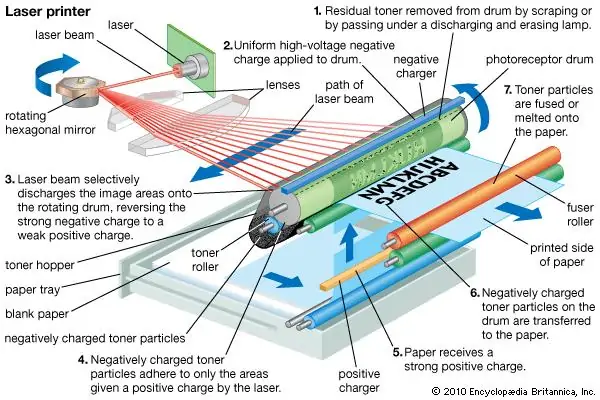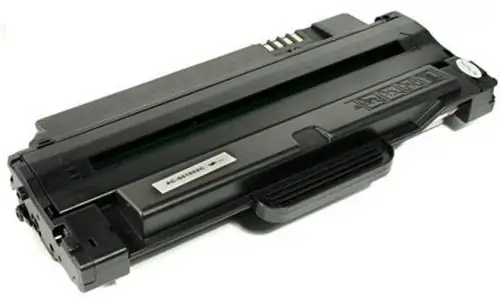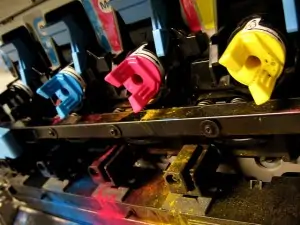What is a toner?
It is one of the key elements for our work to achieve a remarkable quality at the time of being printed, but few know exactly what this mechanism consists of. We refer to toner, whose function and mechanisms we will try to analyze and transmit in the following lines.
When talking about toner we refer to the dust that, electrically charged, consists of two types of elements, on the one hand the pigments and on the other, the plastic. In the first case it is the elements that give color to the text that we are going to print. The function of the plastic is precisely to mix with those pigments, subsequently melting through the toner melting unit.
Meaning of the word toner: this word has several meanings, but we only use it as a mixture of powder to form images using laser xerography technology.
How do toner cartridges work?
How does this process work? In a very simple way. It starts when the transfer roller receives a negative charge, and a uniform negative charge is transferred to the image cylinder. From there, the cleaning blade comes into operation, which mechanically traps the elements, which fall into the waste hopper.
Then, the laser unit comes on, which hits the surface of the image cylinder and generates an electrostatic image. This is possible after the laser beam hits the surface of the drum and causes it to lose its load.
This step results in the developing part, in which the roller releases a layer of negatively charged toner, transferring to the surface of the cylinder only in the parts that are illuminated by the laser light beam.
This process results in the last step, in which the printer selects the sheet and it passes through the image cylinder and the transfer roller. This function supposes a consequence, that is not another one that the toner is attracted towards him by the difference of loads, which generates the impression in the paper.

At this point, it should be noted that the toner is firmly fixed after using heat to melt it on the paper, avoiding spills of material in parallel. It is the key to the process, which allows to obtain a very high print quality.
Laser printing process:
In this video it explains very well the basic operation of laser printing.
Toner powder is a powder that is manufactured by a chemical process, it is a powder similar to the residue left by a candle when this oily dust is burned, it is not exactly the same as for the toner there is a purification process for all the particles have the same size and the same color, the most important thing is that they have an electrostatic charge either positive or negative, according to this designed printer. When you buy a toner for a specific printer and that model comes prepared with the correct electrostatic charge and with the powder to the size (the diameter of the particle) and color required, that’s why the toner powder is specific for each brand or model of printer.
How do we make that powder become the desired impression?
First we would have to explain what parts we can find in the toner cartridge that make laser printing possible
The powder, which is inside the tank on the back of the cartridge. When we buy a toner, many manufacturers ask us to move the toner cartridge vertically and horizontally the cartridge so that the powder does not get stuck, Inside many toner is incorporated the photosensitive cylinder or printing drum, what we want to draw is projected with the laser to this cylinder, the charge of the laser will ionize the cylinder and put an electric charge, the cylinder rotates and when going through the deposit of toner powder, it is stuck to the drum by the electrostatic charge coinciding exactly with what we want to print . the paper is loaded with the opposite load that the cylinder has, with which the image is transferred from the cylinder to the paper, at this moment the toner is only attached to the paper by the load that the paper and the toner have, but it is not yet set.
We would go to the last stage, but out of the cartridge, since this part is always in the printers, the melter comes into operation, which is a roller with an electrical resistance, by means of the pressure and the temperature it exerts on the paper. It melts and anchors it.
After this the cylinder is cleaned a knife removes the excess toner and puts it in a tank for residual toner
The laser prints are very cheap in terms of the price per copy since the toner powder is very economical but the cartridges to incorporate in some cases the drum expensive price.
In the large printers or photocopiers for the amount of pages that print and the high price of its components have everything separated, on the one hand the deposit on the other hand the drum and on the other hand the blades and the waste deposit.
Why does my printer toner stain the sheets?
These drums when loaded must be very careful when removing them from the printer since on the outside with strong lights like the sun (when going ionized) they can lose the electrostatic charge in an irreversible way, and leaves to be stained when they can not draw the laser well the load. It can also be a problem of the blade that does not separate the excess toner well and generate lines from top to bottom.
How much is the toner of a printer worth?
How to clean the toner
In an office environment, the cleaning of the equipment is key and decisive when it comes to extending the life of a laser printer. In fact, toner care is one of the most important parts of toner maintenance. Thus, this does not happen only by cleaning the outer casing.
On the contrary, it is necessary to take care of one of the elements that have more value within these equipment, such as toner. A part of the cleaning that we talked about should focus on toner, part of the printer that stands as the protagonist of the most special care.
In particular, it is important that when you get ready to clean this device do not open the toner. Neither try to shake it, an action that is automatically played when the user notices the first problems in the absence of ink in the laser printer. In this sense, one must bear in mind that there is a risk directly related to this bad gesture, which involves filling the inside of the printer with dust.
As a result of such an error, likewise, one must also know that the clothes we wear at that time can be stained. And worst of all: that it is a very difficult substance to be eliminated, especially if you do not act quickly.
In parallel, they have to take care of the temperature and humidity controls of the printer, although experts say that these two indicators are not decisive for good toner maintenance. In this sense, you have to try to keep the toners unused as well as the equipment in environments where there is not too much light or temperature.
However, in the market there are certain toners that are photosensitive, which is why they have to be specially taken care of and not exposed to the sun in excess. In parallel, and although it seems obvious, you must take special care with the blows and avoid falls, chafing and impact of these products. Especially when they are transported or at the moment of being placed.
In spite of this, specialists recognize again that, as happens with sun exposure, toners must be taken care of delicately and avoid knocks, although the user should not be obsessed with it, since otherwise , is exposed to have more chances of this occurring.
Avoid toner shock when transporting or when it is to be placed. It is composed of very sensitive pieces that can be released at the slightest stroke. We must treat it in a delicate way but as we said before, without obsessing.
How to act in the event of a spill
In parallel, we must take into account how to act in the case of a powder spill, which is the result of the toner handling process when changing it, cleaning it or simply removing it to clean the equipment. So, the first thing we have to do is stop our hands and, quickly, throw warm water and soap. This traditional remedy is very effective when the powder comes in contact with the skin.
Then, if the ink falls on the clothes, do not try to remove the liquid by rubbing it with your hands. In fact, through this mechanism it will spread further and the action will be ineffective. On the contrary, it is best to find a brush and rub it in a strong and fast way.
In the case of using liquid and stain remover and rubbing it with a napkin one makes it penetrate more and its elimination will be a very hard test. On the contrary, a rag and cold water are great remedies if the ink has spilled on the floor, since to aspire it can have the opposite effect, and that is that it spreads more.
What to take into account when buying a toner
There are many experts who believe that the use of printer toner is cheaper for those users who print a large number of documents. Within a minority stream, this element is also chosen depending on the model of printer used and the performance of the ink cartridges that are available.
However, how can we be able to select the toner that best suits us? The printers that use the toner cartridges are the laser printers.
In this sense, there are some criteria that allow us to compare the different types of toner that exist in the market, so knowing them will be of great help before making your purchase.
For this reason, it is essential to know, in the first place, the type of toner that your printer uses, whether it is powder, liquid or laser. To facilitate the task, we recommend that you only compare those toners of the class that your equipment uses.
Next, know and identify what kind of performance your ink cartridges have, what we commonly call the cartridge life. It consists of a number that as a rule is printed on the toner box. However, it can also be located on the manufacturer’s website. With this indicator in your possession you can know the number of pages that can be printed from a toner cartridge. So all you have to do is buy that identifier with respect to those toners that you are thinking of buying.
To facilitate this process, you must divide the number of pages you calculate of the cartridge’s performance between the price of printer toner, operation from which we will obtain the cost of each page. Again you will have to compare the result of all the toner that is in your mind to buy, a comparison that will help you to verify what is the true price of toner.
This is because in practice a toner can have a cost of more than 15 euros on average higher than another model. However, by making this comparison based on the cost per page we will find that in the long term the one with the highest price can yield more.
Finally, it is also important to know and compare the useful life of the toner. And in some cases can last less than a year and a half, so for those users who make impressions in a timely manner would not be a convenient choice. Therefore, we must take into account the number of impressions that are going to be made, in addition to their rhythm and duration, before selecting the toner that we are going to buy.
Liquid toner
The way to print with liquid toner is practically the same as the one done with powder toner, but the following peculiarities can be highlighted:
The constitution of the toner for obvious reasons is different in a significant way. The particles of toner are suspended in an insulating liquid, for that it is typical to use paraffin, these particles are attracted by the charge of the drum as it happens in the printers of toner powder.
As the liquid toner is inside the fluid and it is easier to control the size of the particles it is much smaller and this makes the resolution with which it can be worked is greaterAmong the parts of the toner we find the following:
- Toner powder
- Dosing blade: It is responsible for regulating the amount of dust that must be moved from the deposit of the same to the magnetized cylinder. As this blade wears, the prints start to come out with stripes.
- Toner powder deposit: Here the powder that will be «impregnated» in the paper by magnetism is stored and fixed by a laser action.
- Cleaning blade: Its function is simple. Remove the toner that did not adhere to the paper and return it to the waste toner box. If it is not perfectly installed, the sheets that are printed may include stains or could damage the magnetized cylinder.
- Toner chips: They are used to analyze the performance of the toner itself. Keep track of the number of pages printed, remaining toner, etc.
- Waste toner tank: It is smaller than the main tank, since toner that is left over after making a copy is collected.
- Primary charge roller or PCR: Apply electricity with a negative charge to the OPC cylinder so that the laser can trace what is requested on it.
- Magnetized Cylinder: This tube is responsible for transporting the toner from the deposit to the paper.
- OPC cylinder unit: It is the mechanism on which the laser acts. This is loaded in a negative way so that later the laser writes or draws on it and impregnates the dust on the sheet.
What is a Printer Toner?
A printer toner, laser toner or toner may be described as the consumable component of a laser printer. A printer toner is comprised of dry toner powder which is a mixture of carbon, plastic or polyester, polypropylene wax, black and other coloring pigments. We explain how the toner works and the different components that make up the printer toner and much more in this article. Read on!
What is a Laser Printer?
A laser printer is a type of printer where the keys don’t strike the paper. These printers make use of a non-impact photocopier technology. The first laser printer was introduced by IBM in 1975, but it was made only for mainframe computers.
It was Hewlett-Packard which made laser printers a popular device, with the launch of LaserJet. LaserJet was made for personal computers and was reasonably priced. Laser printers of today are cheaper than they have ever been in the past, and far more efficient. While HP is still the leading manufacturer of laser printers, it is closely followed by Xerox, Okidata and Lexmark.
A Laser Printer Comprises of the Following Components…
- Toner Cartridge
- High Voltage Power Supply
- Laser Scanning Assembly
- Paper Transport Assembly
- DC Power Supply
- Transfer Corona Assembly
- Formatter Board
- Fuser Assembly
The toner cartridge comprises of a print drum, toner, cleaning blade and a charge corona wire. For the purpose of this article, we are specifically interested in the printer toner.
How does a Printer Toner work?
The printer toner is something most of us take for granted – we don’t think much about it because it is such a simple thing and works so well for the most part. When the printer runs low, just put in a new toner cartridge and it starts working perfectly yet again.
The toner is comprised of powdered plastic. The thing about plastic is that you can manipulate it as you like with static electricity. You can also melt the plastic and fuse it onto paper to create clear and perfect images.
Printer toners make use of a technique called xerography, which means printing with paper rather than with ink. It works pretty much the same manner in printers as it does in photocopier machines.
In fact, the laser printer was invented by a certain Gary Starkweather, an employee of Xerox, the world’s leading maker of photocopier machines, in 1969.
Photocopier machines comprise of a rotating drum coated with selenium, a semiconductor. The selenium coating converts light into electricity, much in the manner of a solar cell.
When the bright light of the laser beam is bounced off the paper onto the drum, a type of static charge is created, which has an effect on the toner. As the laser is scanned directly onto the drum, an electrostatic charge is created, which can be used to generate various types of electrostatic images.
Evolution of Printer Toners
Back in the 1970s, when printer toners were first introduced, they were quite basic and contained only rust and soot for the most part. The rust, or iron oxide, was magnetic and allowed superior control during the imaging process.
But color printing was not possible with the toners of old. The reason was the dark oxide contained in the rust made the colors brown. Color printing was only introduced in 1994 as manufacturers added more refinements and additives to the toner for better speed and image quality.
What are the Different Components of a Printer Toner?
Here’s a look at the different components of a printer toner….
Polyester/Plastic – Most color toners are made of at least 85% to 95% plastic or polyester which is broken into a very fine powder. The grains have to be made as small as possible for better image resolution. The thing about plastic is that is that while it does not conduct electricity, it holds a static charge. This means plastic can cling to anything that gives an opposite charge. This property of plastic is made use of by laser printers. They use the power of plastic to cling to things under static charge to ensure that the toner gets onto the imaging drum and from there onto paper.
Carbon Black – Polyester, which is the main ingredient in toners, is not black, it is clear. So in order to make it appear black, makers of printer toners add carbon black, which is essentially a high-purity soot to it. This high-purity soot is produced by burning creosote or tar and is usually used to make rubber products such as tires tougher and stronger. Carbon black is a class II carcinogen, it ensures that the toner is sealed in place once it hardens on the paper.
Fumed Silica – The fumed silica or SiO2 provides a silky or liquid flow to the polyester toners. This substance looks like microscopic glass beads and are considered essential for spreading the toner across the page at superfast speeds especially in an office environment.
Charge Control Agents – When the toner leaves the toner cartridge, it clashes against the metering blade, which results in a static charge. This is referred to as Tribo-electrification. With charge control agents you can put a negative bias to the toner, which ensures that it clings to the imaging drum. The charge control agents consist of bits of zinc, iron and chromium and they ensure that the toner holds on to the charge.
Pigment Yellow 180 – A color printer should have separate cartridges for magenta, cyan, yellow and black. The yellow color comes from Pigment Yellow 180, which is an organic pigment or a benzimidazolone compound.
Pigment Red 122 – The red color in the toner used in a color printer comes from Pigment Red 122, which is a Quinacridone compound which features a range of reddish hues. This is a highly durable substance, which is why it is used in exterior paints.
Pigment Blue 15:3 – Cyan is one of the colors used in color printers and this is produced by Pigment Blue 15:3, or the compound copper phthalocyanine. This is a common pigment which is used in solar cells and even in quantum computers.
Polypropylene Wax – Polypropylene wax is an essential ingredient used in printer toner for lubrication. It is a solution to an old problem with toners, where the toner would stick to the fuser rollers and the next page would get smudged. Polypropylene wax is a polymer much like polyester but has much longer carbon strands and fewer amounts of chemicals hanging out of the strands. This means there is enough space for molecules to slide or slip past one another.
What is the Difference between Toner Cartridges and Ink Cartridges?
There are two types of printers – laser printers and inkjet printers. Laser printers, which make use of toner cartridges, are different from inkjet printers, which make use of ink cartridges. Inkjet printers spray liquid ink onto paper through microscopic nozzles to create a printing pattern.
Toners differ from ink cartridges when it comes to functionality and the format or the printing patterns. There is also a lot of difference between the two with respect to the benefits. Let’s take a look.
Replacement Cost
One of the things to consider when replacing a cartridge is the replacement cost. There is no question that toner cartridges are more expensive than ink cartridges. However, while the initial expense of inkjet cartridges are low, the costs start adding up over a period of time. While a toner costs much more up front, it is more durable and lasts much longer, which makes it more cost-effective over the long term.
Inkjet cartridges don’t last long and will have to be replaced frequently. The cost of the replacement may be affordable, but when you buy too many of them, they can get quite expensive. Also, ink cartridges don’t print as many pages as a toner cartridge and have to be replaced every so often. This makes toner cartridges more cost-effective over a period of time.
Speed and Capacity
There is no question that laser printers are much faster than inkjet printers. They are the best option for those who expect the speed of the printing to be high. The electromagnetic process that takes place in laser printers is extremely precise; so you can print hundreds of pages in just a few minutes without a break. This makes laser printers ideal for the office environment, where the requirement is for high speed and capacity.
Inkjet printers are much slower than laser printers. They are not as precise as laser printers either and not capable of high printing speeds and capacity. They are better suited for home use rather than for use at an office or a store. If speed and capacity of printing is what you’re looking for, laser printers are an obvious choice.
Image Quality
When it comes to the image quality, laser printers are considered to be far superior to inkjet printers. While there are some models of inkjet printers that produce highly colorful and vivid images, this is not true of all inkjet printers. It is not possible for inkjet cartridges to match the precision of the laser drawn imagery of the printer toner. Also, with inkjet cartridges, it is difficult to get the desired image quality and to avoid smudges.
How Does a Laser Printer Toner Work?
Here is a quick explanation of the Electrophotographic (EP) Print Process. This takes place in 6 stages.
#1: Charging – In the charging stage, a strong negative charge is applied to the surface of the toner drum through the charge corona wire contained in the toner cartridge.
#2: Exposing – During this stage, the laser scans the drum from one end to another and turns on and off according to the signal received from the formatter board. The charge received by the toner drum is reduced substantially in areas that are touched by the laser beam. The image is built up on the toner drum surface once the drum starts rotating.
#3: Developing – The toner is then transferred to the various areas of the drum that have a slight negative charge. The printer toner is attracted by the magnet inside and sticks to the roller because of the electrostatic charges that are built.
#4: Transfer – The registration rollers receive signals from the formatter board so that the paper can be sent through. The rollers move the papers in between the drum so that the image is properly transferred to the paper. A high positive charge is applied to the paper, which attracts the toner, which is negatively charged. Any jamming of the printer is prevented by the static eliminator comb.
#5: Fusing – This is the next stage of the printing process. The toner is only loosely attached to the printing paper up to this stage. Then the fuser, which consists of a pair of heated rollers, uses the high temperature to melt the toner onto the printing paper. The paper is passed through the roller fast so that it does not get burned up.
#6: Cleaning – Cleaning is the last stage of the printing process. During the cleaning, a bright light is beamed on the photoreceptor surface, which erases the electrical image. Following this, the drum surface passes through the corona wire and the positive charge is re-applied.
How do Color Printers Work?
Back in the past, most commercial laser printers could only manage monochrome printing, or black printing on white paper. But since the 1990s, color laser printers have become very popular. Color printers work in the same way as black and white printers, but they go through the entire printing process 4 times.
Color printers use a special type of printer toner which includes color pigments of the following colors – cyan, magenta, yellow and black. By combining the four different colors in different proportions, you can generate an entire spectrum of different colors.
Some of the latest printer models feature a separate printer unit for each color, comprising of a drum, laser assembly and toner system. The paper is moved seamlessly through the various drum heads and collects the four different colors in different combinations before placing the image onto the paper.
What are the Different Types of Printer Toner Cartridges?
There are essentially 3 different types of toner cartridges based on how they are manufactured….
Genuine — Genuine printer toner cartridges are also referred to as OEM cartridges or those made by the original equipment manufacturer. They are sold by the printer manufacturers, such as HP or Xerox. These OEM cartridges come with excellent guarantees and feature only a genuine brand printer toner. The printer manufacturer may warn you about using only branded and genuine OEM printer toner cartridges with their printers. If you don’t, you risk losing your equipment warranty. The only real issue with these Genuine OEM toner cartridges is that they are expensive.
Compatible – Compatible or generic toner cartridges are those that are manufactured by third-party companies. They are sold under various brand names and differ only slightly in comparison to OEM toner cartridges at design, look and page yield. These cartridges are cheaper than Genuine OEM toner cartridges. They are also less reliable – while some of these cartridges may contain more toner and print more pages than original cartridges, others may not last that long. Some of the compatible toner cartridges provide a very subpar print quality and may give you pages with dirty backgrounds. So you should do your research on the reputation of the manufacturer before buying compatible cartridges.
Remanufactured – In Remanufactured toner cartridges you are basically refilling the cartridge with new toner. These are refurbished cartridges where the worn or damaged parts are changed. The quality of the toner and the remanufacturing process varies from one manufacturer to another. Some of the remanufactured cartridges cannot be relied upon – they are known to malfunction, leading to the leaking of the toner, and even resulting in a lot of damage to the printer. So you should be careful when choosing remanufactured cartridges, and test them out before using them. There are many companies that make high quality remanufactured cartridges where care is taken to ensure that there is no leaking of the toner under any circumstance. Remanufactured toner cartridges are popular because they are much cheaper than OEM cartridges.
Is Recycling of Toner Cartridges Possible?
Yes, recycling of toner cartridges is a widely followed practice. There are many remanufacturers of toner cartridges that collect old or empty cartridges from customers and fill them up with new printer toner. They make sure to salvage 90% of the components from an old cartridge. The recycled or remanufactured cartridges are sold at a steep discount in comparison to the market price.
Recycled cartridges reduce the dependency on petroleum which is used in the production of new toner cartridges, and help minimize the carbon footprint. That’s why even original equipment manufacturers such as Hewlett Packard have launched comprehensive recycling programs for used cartridges.
- Epson Expression Photo XP-8700 | Análisis y Opiniones - 6 julio, 2022
- HP LaserJet M110we y M110w | Análisis y Opiniones - 23 junio, 2022
- HP Color LaserJet Enterprise M554dn | Análisis y Opiniones - 10 marzo, 2022


 A4toner: Cartuchos de tinta, toner e impresoras
A4toner: Cartuchos de tinta, toner e impresoras



